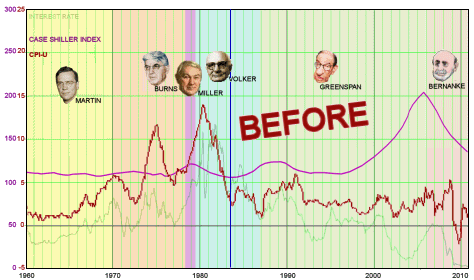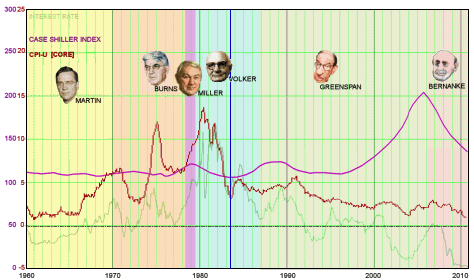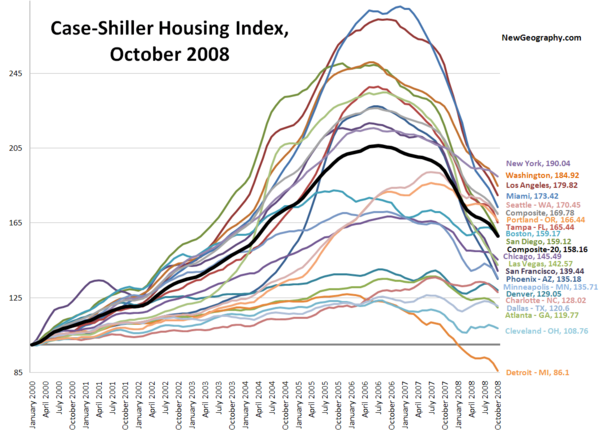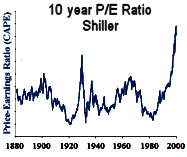
Since then, I have learned that the CPI-U comes in two flavors – NSA and SA , non-seasonally adjusted and seasonally adjusted. It also come as CPI-U, excluding food and energy called "Core Inflation." So I redid my graph accordingly with the seasonally adjusted Core CPI-U. Not too much different, less volatile perhaps.:

In January 1983 housing prices were replaced with owners’ equivalent of rent because rents are more stable. Because house prices rose and fell more than rents during the housing bubble and crash, housing’s effects on inflation and deflation are not reflected in the CPI.

The indices are calculated from data on repeat sales of single-family homes, an approach developed by economists Karl Case, Robert Shiller and Allan Weiss. Case developed a method for comparing repeat sales of the same homes in an effort to study home pricing trends. He was using data from house sales in Boston in the early 1980s, which was going through a housing price boom. While Case argued that such boom was ultimately unsustainable, he had not considered it a bubble, a commonly-used term to describe similar market trends. Case sat down with Shiller, who was researching behavioral finance and economic bubbles, and together formed a repeat-sales index using home sales prices data from other cities across the country. In 1991, while Weiss was performing graduate studies under Shiller, he persuaded them to form a company, Case Shiller Weiss, to produce the index periodically with the intent of selling the information to the markets. Fiserv, an information management company, bought Case Shiller Weiss in 2002 and, together with Standard & Poor, developed tradable indices based on the data for the markets which are now commonly called the Case–Shiller index. Options and futures based on Case–Shiller index are traded on the Chicago Mercantile Exchange.
 Back in 1995 and 1996, apparently this index wasn’t available widely, if at all. And looking back, the housing bubble hadn’t even started [top graph]. So it’s hard to even say that housing was a player in those salad days. Recall that the thing that Shiller presented to the Fed on December 3, 1996 had nothing to do with housing, it had to do with the Stock Market in general. It was the graph where Shiller had compared the price of the Stocks in the index to their average profits over the last ten years. And what it showed was that Stocks were overpriced – way overpriced [like 1929 way overpriced].
Back in 1995 and 1996, apparently this index wasn’t available widely, if at all. And looking back, the housing bubble hadn’t even started [top graph]. So it’s hard to even say that housing was a player in those salad days. Recall that the thing that Shiller presented to the Fed on December 3, 1996 had nothing to do with housing, it had to do with the Stock Market in general. It was the graph where Shiller had compared the price of the Stocks in the index to their average profits over the last ten years. And what it showed was that Stocks were overpriced – way overpriced [like 1929 way overpriced]. I’m making a point with this rambling review. The housing bubble didn’t destroy the Stock Market and our economy. It was the other way around. Alan Greenspan’s management of the Federal Reserve itself actually caused the problem. By keeping the rates low in 1995, he feuled the explosion of speculative dotcom companies and the Stock Market in general. He fueled the cascading building industry. He fueled the borrowing, buying frenzy in the housing market that became the housing bubble. When the dotcom bubble burst in 2000, he made a second mistake and drastically lowered Interest Rates and stimulated things even more. By the time Bush was inaugurated, the scene was set. All that was needed to turn it into a blood bath were Bush and Cheney’s ignoring domestic issues altogether and Phil Graham’s coup de grâce – the Commodity Futures Modernization Act of 2000.that made Derivative trading available to make already difficult matters immeasurably worse.
Sorry, the comment form is closed at this time.